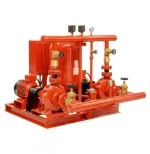Fire pumps are necessary when the water pressure available is not sufficient to meet the demands of a standpipe or sprinkler system. They can be powered by electric motors, diesel engines or steam turbine systems.
The fire pump must be sized based on a hazard analysis and a water flow test. If a backflow preventer is used, it must be located a minimum of 10 times the pipe size diameter from the suction flange.
PSI
The PSI of a fire fighting water pump refers to the force of the water flowing from the pump and out through the hose. The higher the PSI, the more force the water has.
It’s possible for a fire pump to have a high PSI without having the power to deliver the required flow. This is because most pumps are rated based on the maximum head they can achieve (the height from the original water source up to the highest point at which water can be pumped – also called the discharge point).
A good way to find out how much pressure a fire pump can create is by looking at its performance curve. These are plotted on a graph that shows the flow of water (usually the “x” axis) against the net pressure produced by the pump at various conditions between churn and 150 percent of the rated flow. A good MPO can use this information to choose a fire pump that will be capable of supplying the desired building system demand.
GPM
Fire fighting water pumps must have high pressure, as this will increase the Total Dynamic Head (TDH) and therefore how far the pump can spray. However, too much pressure and the pump could break under its own weight, so it’s important to calculate what kind of power you need before purchasing a fire fighting water pump.
To determine if a fire fighting water pump will have enough pressure and flow to satisfy system demand, use the manufacturer’s performance curve for the model fire pump under consideration and compare it with the water supply pressure at a location where the fire pump’s discharge flange will be installed. Then, find the net pressure at churn and system flow demand by adding the pump’s suction pressure and the water supply’s residual pressure.
Often, a building’s municipal water doesn’t have enough volume or pressure to meet its system demands, so it requires fire pumps that boost the water. This is especially true for high-rise buildings, where the water has to overcome gravity.
Hose Size
One of the most important factors to consider when choosing a fire fighting water pump is its hose size. The bigger the hose, the more water it can hold at a time and the higher its pressure will be.
The hose should also be able to handle the maximum amount of water it can pump over an extended period of time. Choosing the wrong hose size could cause spray patterns to not develop correctly or not provide enough pressure to a hydrant or other fire fighting equipment.
Fire hoses are typically made in two different styles: straight roll and donut roll. Straight rolls are easier to store and load onto fire engines, but donut rolls are much more flexible and easy to deploy. Additionally, hoses can have either hard or soft sleeves. Hard sleeves are designed to withstand high amounts of pressure, while soft sleeves are used in mop-up operations and for transporting water. The hose’s diameter is an essential factor in its overall performance as well.
Noise
A fire pump can create significant noise when pulsations occur. This type of noise is caused by the pump colliding with and striking parts inside itself, especially when the pump is operating. It is also caused by a poorly designed or installed piping system. Using rubber vibration isolation mounts can help dampen the impact and reduce pulsations.
Fire pumps are an essential component of many water-based fire protection systems, increasing the pressure (measured in psi) of a water source when the supply is insufficient for the sprinkler system it’s supplying. The proper design, installation, and acceptance testing of fire pumps is essential to ensure they are ready to function as required.
Ask the potential pump manufacturer to provide the rated performance for each port on its main body and verify that the hose loss numbers are the same for all the ports assigned. Matching outlets with hoses that have the lowest loss monitors will help to lower operating pressure and eliminate pulsation.
